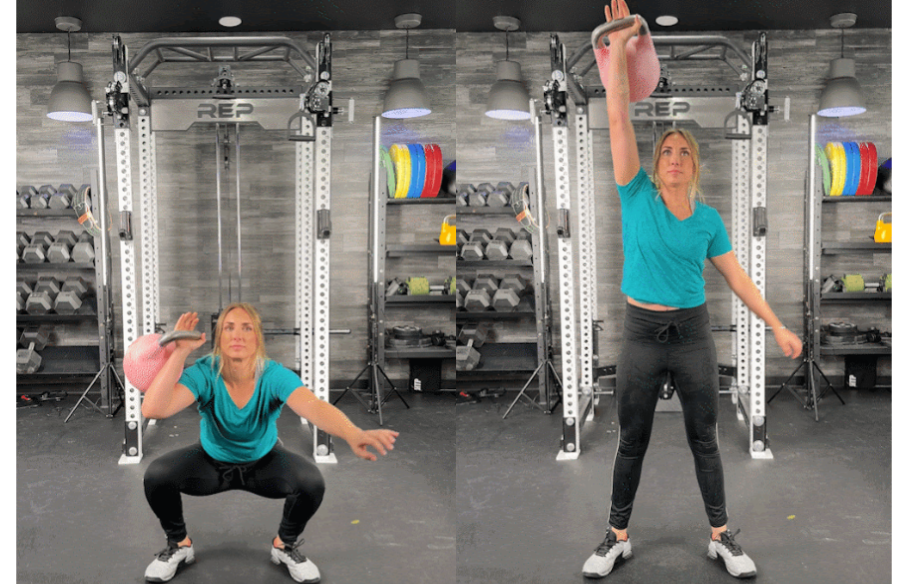We test and review fitness products based on an independent, multi-point methodology. If you use our links to purchase something, we may earn a commission. Read our disclosures.
CrossFit folks know a thing or two about thrusters. They dread the pain cave they’ll be visiting whenever they see that word scrawled in dry erase marker on the box’s whiteboard.
For those not in the know, the thruster is a compound exercise that combines the classic squat and push-press movements while adding in an element of explosiveness.
Rather than simply squatting, standing, pressing, and repeating, the thruster entails exploding out of the bottom of the squat and using the force and momentum from this to essentially launch the weight into the overhead position.
The result is a highly effective compound exercise that targets multiple muscle groups; improves your overall strength, conditioning, mobility, and flexibility; and absolutely annihilates most people during the WOD.
Today, we’re tackling the kettlebell thruster, which provides similar benefits as traditional barbell thrusters but requires less equipment to perform. We’re covering how to do them, providing tips for proper form, and calling out common mistakes to avoid as you learn.
Are you ready to work thrusters into your full-body kettlebell workout and reap the innumerable benefits associated with this exhausting yet effective exercise?
Let’s get it!
How to Do a Kettlebell Thruster
- Grab two kettlebells and get them into the front rack position. Stand with your feet shoulder-width apart. This is your starting position.
- Brace your core and descend into a squat, keeping your back straight, chest high, weight on your heels, and knees tracking over your toes.
- From the bottom of the squat, drive through your heels and explode upward, standing tall and pressing the kettlebell overhead. The heel drive and hip hinge motion will propel the kettlebells so you don’t solely rely on your arm strength to press them overhead.
- Lock out your arms at the top of the movement and hold briefly before bringing them back to the front rack position and cycle into the next rep.
- Repeat as needed.
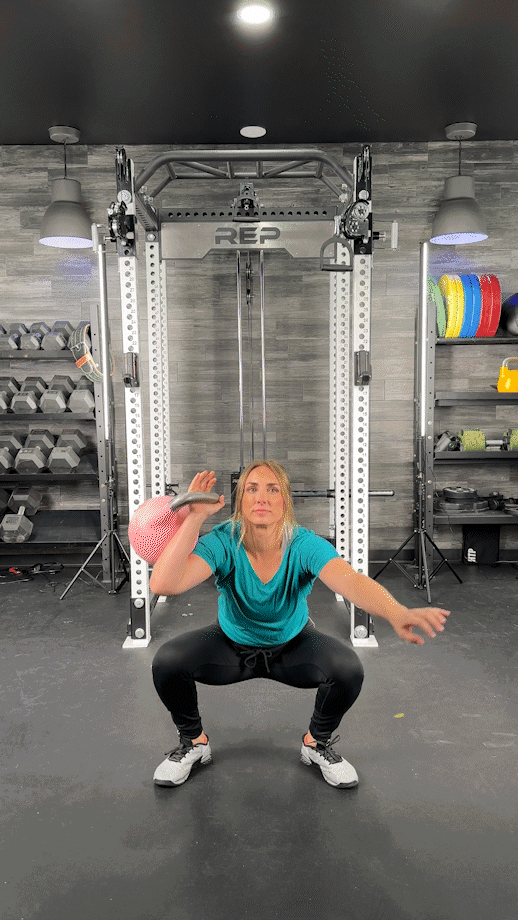
Trainer Tips for Form
The kettlebell thruster is one of the best kettlebell exercises available, but it’s not the easiest to learn. Here are some trainer tips to help you develop proper form.
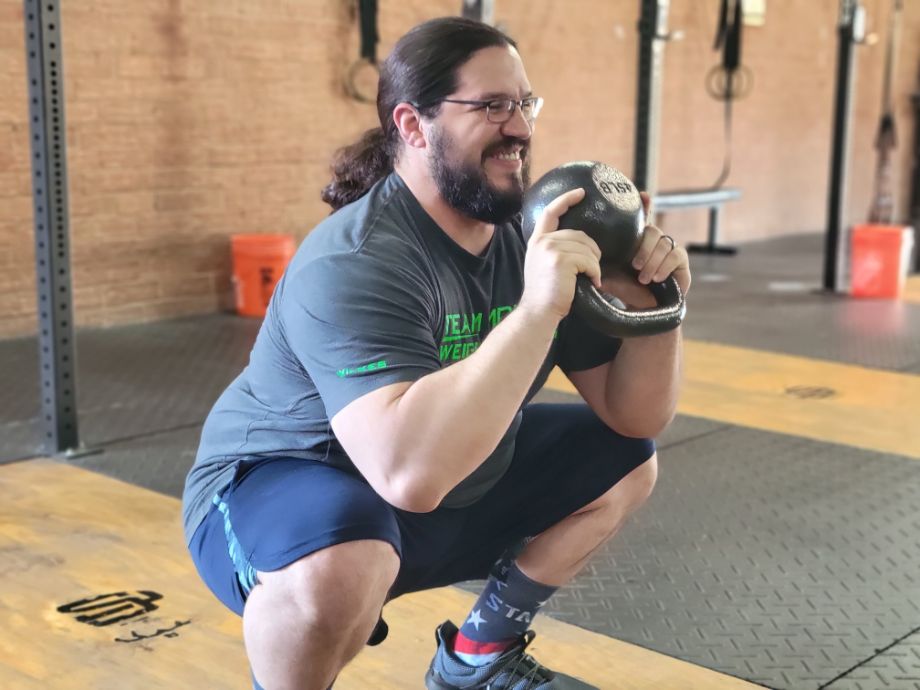
Work On Goblet Squats
Mastering the KB thruster takes strength in your legs, core, and upper body, as well as good mobility in the hips and ankles. Starting out with a less technical exercise like the goblet squat can be very beneficial for beginners.
“The goblet squat targets many of the same muscle groups as the kettlebell thruster,” says GGR Head of Content Kate Meier, “and features a similar movement pattern, making it a great stepping stone when first learning the thruster.”
RELATED: How To Do Goblet Squats
Improve Squat Depth
Kettlebell thrusters require a great deal of mobility and flexibility, so an inability to get into a deep squat position due to poor hip mobility or tightness is only going to hurt your ability to generate power on the heel drive.
You can improve your kettlebell squat depth by incorporating dynamic movements like leg swings, hip circles, and bodyweight squats into your warm-up exercises. Mobility exercises like ankle rocks, wide stance rocks, and T-spine rotations help improve your range of motion, too.
Drive Through the Heels
Driving through your heels is an essential part of the regular squat, but it’s also how you’re going to turn the overhead press portion of the thruster into the explosive movement that it’s meant to be. A strong drive engages your glutes and hamstrings, generating significantly more power than you could get from pushing your arms upward unassisted.
If you want a strong kettlebell thruster, the power derives from the heel drive.
Practice Kettlebell Strict Presses
Kettlebell strict presses are super helpful for building a thruster foundation.
The strict press provides activation to the shoulders, upper back, and core, all of which will be essential during the thrust portion of the thruster exercise.
Pressing using kettlebells also gives beginners some much-needed practice in stabilizing a kettlebell in the precarious overhead position. The last thing you want is to get a strong heel drive and hip hinge out of squat and execute an excellent thruster only to have the kettlebell slip from your grip and come crashing down on your head. Mega ouch!
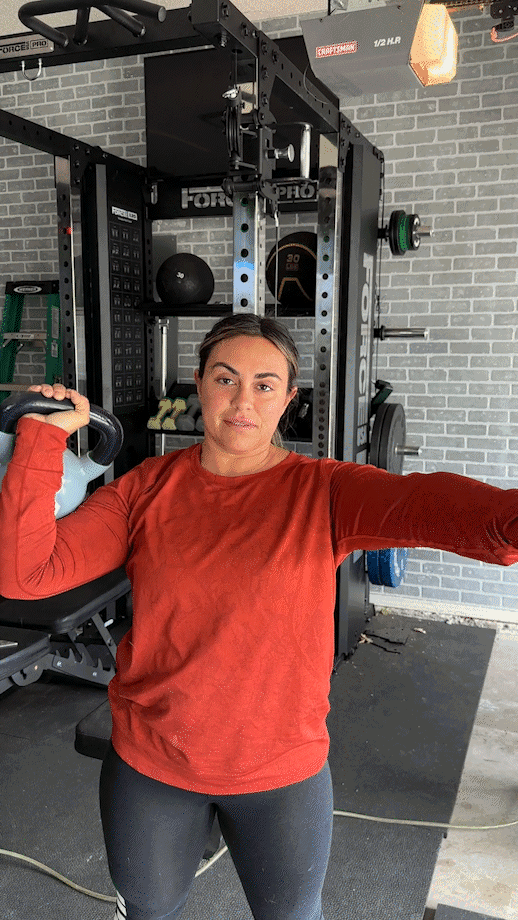
Common Kettlebell Thruster Mistakes
Perfecting your kettlebell thruster form can be tricky. Here are a few of the most common kettlebell thruster mistakes and advice on how you could avoid them.
Poor Front Rack Position (Letting Elbows Fall)
As fatigue sets in, many people will find themselves falling forward, their elbows slowly dropping, their backs rounding, and their weight shifting forward onto their toes.
Stability is key during the kettlebell thruster. That means holding a strong rack position with your core tight, back straight, feet planted, and elbows held at shoulder height.
If you find your form starting to crumble, put down the kettlebells and take a breather. You may not want a mid-WOD break when you’re on a timer, but your health and safety always trumps your Fran score, even if it doesn’t always feel that way.
Heels Raising Off Of The Ground
Coming up onto your toes as you rack up a bunch of reps is a telltale sign that fatigue is setting in. If your form is suffering, take a quick breather to regain your composure before diving back in and closing out the set.
Shifting your weight from your heels to your toes almost immediately, on the other hand, indicates that you probably went too heavy. Sloppy form does you no favors, so put the heavy kettlebells back and grab something you can manage with good form on every rep.
Form comes first. Always, always, always.
Knees Caving Inward
Those final reps are often hard-earned, and that’s when your form really starts going downhill. You might find your knees caving inward as you struggle to push yourself up from the bottom of your squat.
This is no good, as, when your knees cave inward, it puts undue stress on the knee joint and increases your risk of injury. Push your knees outward as you come up out of your squat to combat this effect and protect those precious knee joints.
Improper/Weak Grip on the Kettlebell
Achieving the perfect grip is an exercise in finesse. Too much grip, and you’re going to exhaust your forearms before the set is through. Too little grip—KERPLUNK!
Find that sweet spot that gives you complete control over the kettlebell without overdoing it so you get the most effect from your thrusters while maximizing your safety in the process.
Arching Your Back At Elbow Lockout
The rush you get from standing tall and strong is invigorating. It’s OK to be proud, but don’t accidentally puff out that chest and wind up arching your back at full elbow lockout.
Arching your back takes your spine out of alignment and increases your risk of injury. We want to hobble around the next day because of DOMS, not because we’re actually injured. Keep a flat back throughout the entire exercise, especially at the end, to protect your spine.
Engaging your core muscles provides some additional support to the spine, as well, so be sure you’re doing this.
Starting the Squat Too Early
Like the kettlebell swing, the success of the KB thruster hinges on a powerful hip thrust and making the most of the momentum it creates. Rather than a squat followed by an overhead press followed by a squat and so on, you want to seamlessly transition from one exercise into the next into the next, cycling reps smoothly.
That means, as the kettlebells come down from the overhead position, you want to work with gravity to catch them in the front rack and descend back into a squat fluidly. Squatting too early botches the timing and gives the kettlebells a greater distance to travel, increasing your chance of crashing down into the front rack position and contributing to or causing unnecessary injury.
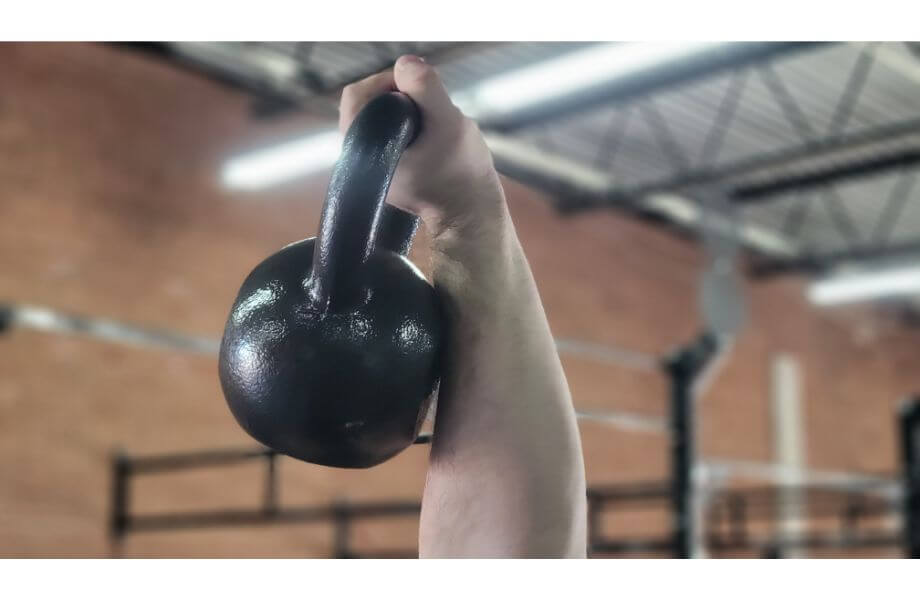
Kettlebell Thruster Variations
Once you gain proficiency on the standard kettlebell thruster, there are many variations you could use to change the stimulus. Here are some of our favorites.
Single-Arm Kettlebell Thruster
So, we’ve covered what’s essentially a double kettlebell thruster, but can the thruster be performed with a single arm and kettlebell instead?
You betcha!
This unilateral variation involves hiking one only kettlebell into the front rack position and performing the thruster following the steps detailed above. It’s incredibly useful for correcting strength and muscle imbalances, but poses additional challenges to your stability and balance.
Goblet Kettlebell Thruster
Another variation that uses but a single kettlebell is the goblet kettlebell thruster. Just as with the goblet squat, you hold the kettlebell into your chest during the squat portion before pressing it overhead.
If we didn’t stress enough how important a good grip is on the standard kettlebell thruster, it’s even more important now. It’s all too easy for a kettlebell to slip out of your sweaty hands and plummet onto your skull when fatigue starts setting in.
Be extra cautious, keep a solid grip on the kettlebell, and use chalk if you find your palms getting just a tad clammy.
RELATED: Chalk Monster review
Useful Kettlebell Thruster Accessories
Shopping for fitness accessories really is half the fun of trying out new exercises, isn’t it?
There’s not a lot of swag associated with enhancing your kettlebell thruster performance, but there are a few things that could make a difference during the set.
Wrist Wraps
Kettlebell exercises like kettlebell thrusters, kettlebell cleans, and kettlebell snatches require a great degree of wrist flexibility to accommodate the kettlebell’s unique weight distribution.
The best wrist wraps are lightweight, portable, inexpensive, and provide extra stability to the ever-important wrist joint when you’re moving heavy weights around.
Wrap them up before the set to protect them from strain, hyperextension, and other injuries.
Change Plates
If you happen to already have a great set of weight plates, you won’t need to shell out for a fancy pair of weightlifting shoes—although a beautiful pair of shoes never hurt, either!
Standing on change plates with your heels in an elevated position helps improve ankle mobility, hip mobility, and proprioception, all of which contribute to a greater squat depth and, in turn, facilitate the kettlebell thruster exercise.
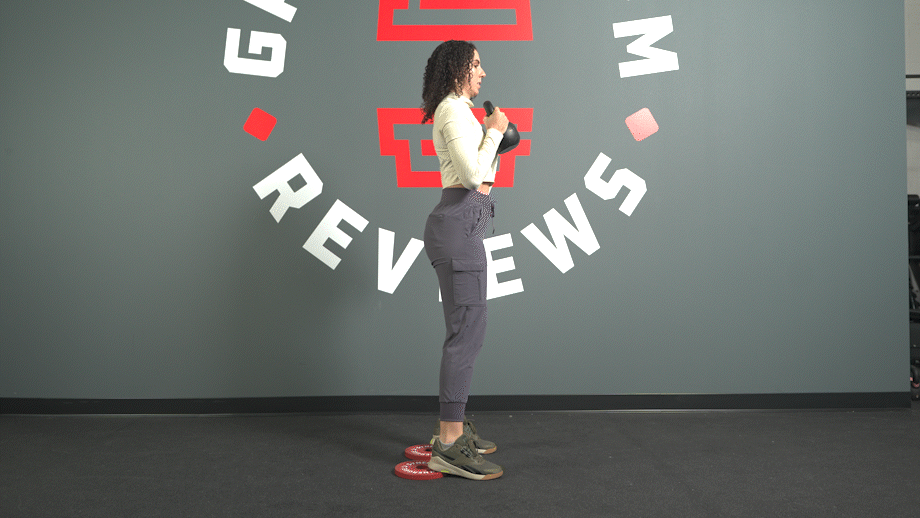
FAQs: Kettlebell Thruster
What muscles do kettlebell thrusters work?
The kettlebell thruster is a full-body exercise that targets just about everything head to toe.
Expect incredible activation in your quads, glutes, hamstrings, calves, rectus abdominis, traverse abdominis, erector spinae, obliques, deltoids, rhomboids, traps, triceps, and forearms.
What are the benefits of kettlebell thrusters?
A lot of people are scared to include kettlebell thrusters into their regular kettlebell training regimen, and for good reason! It’s definitely among some of the most exhausting exercises out there!
That hard work pays off in a big way though, as kettlebell thrusters:
-Target multiple muscle groups
-Increase muscle strength and size
-Improve cardio, endurance, and stamina
-Improve mobility and flexibility
-Improve functional fitness
-Facilitate ADL
-Enhance sport performance
-Strengthen the core
-Torch calories
Because of these many, many benefits, the kettlebell thruster makes an excellent addition to any comprehensive strength training, conditioning, and/or other well-balanced fitness regimen.
Are thrusters better than squats?
Thrusters can be better than squats, but the same is true in the reverse depending on the criteria. For example, squats are better for improving lower body strength, predominantly in your quadriceps and glutes, because it’s generally possible to squat a much heavier weight than you can perform a thruster with.
Likewise, thrusters require cycling reps quickly and rely on explosiveness to propel the kettlebell, or other free weight, into the overhead position. In this regard, thrusters are better than squats because they build more explosive power and provide more cardio benefits than the squat can.
The squat is deliberate, prioritizing strength, while the thruster is swift, prioritizing power. Which one is best depends entirely on your personal fitness goals.
Further reading

CrossFit folks know a thing or two about thrusters. They dread the pain cave they’ll be visiting whenever they see that word scrawled in dry erase marker on the box’s whiteboard.For those not in the know, the thruster is a compound exercise that combines the classic squat and push-press movements while adding in an element of explosiveness. Rather than simply squatting, standing, pressing, and repeating, the thruster entails exploding out of the bottom of the squat and using the force and momentum from this to essentially launch the weight into the overhead position. » Read more about: Kettlebell Thruster: The Full-Body Blaster You’ll Love to Hate » Read more

The Adidas Adipowers and Nike Romaleos 2 are the most popular weightlifting shoes currently available. So, we put them head to head to figure out which is the best. Read more

In our Oura Ring review, GGR's fitness experts and certified personal trainers look at if this uniquely designed fitness tracker is better than the rest. Read more

What did our tester think of these unique, versatile wall bars? Find out in our BenchK Wall Bars review! Read more

